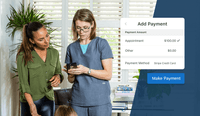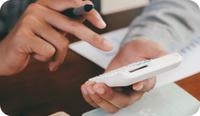What’s the Purpose of SOAP Notes?

Wondering about the purpose of SOAP notes? Essentially, the purpose of SOAP notes is to provide an easy-to-remember formula for comprehensive and efficient note-taking.
Since capturing clear, accurate documentation is an essential part of a therapist’s work, you may want to use the SOAP note method to save time and simplify your note-taking process. It may be helpful to check out our guidance on how to write a SOAP note.
SOAP notes’ objective and benefits
Two of the main benefits of using the SOAP note format are to help facilitate ongoing care and to comply with insurance providers’ requirements for documentation.
Facilitating ongoing care
The SOAP note’s objective, and the point of great note-taking in general, is to accurately track client progress and facilitate smooth continuation of care from one session to the next.
It’s helpful to be able to glance at a client’s most recent note and remember what we discussed during our last meeting or use previous documentation to inform the course of future treatment.
Working with insurance
Good record-keeping also enables therapists to confidently comply with insurance billing and audits. Though each insurer’s standards can vary, most insurance providers want to see proof that clinicians have logged the pertinent details of each session we facilitated.
When therapists present clear documentation of client sessions, we demonstrate to insurance companies that we are trustworthy providers.
The SOAP note’s objective is to standardize, simplify, and improve clinical note-taking. This can help reduce the hassle associated with insurance.
SOAP is an acronym which stands for: Subjective, Objective, Assessment, and Plan. In comparison to simple progress notes, SOAP notes are structured with predetermined sections, which helps us to better organize our thoughts about treatment planning and documentation.
In this article, we explain how each category in the acronym contributes to the overall purpose of SOAP notes and provide examples of how each section can be notated.
Subjective section
The purpose of SOAP notes’ Subjective section is to add information gathered directly from clients in our clinical notes. Their comments about relationships, current stressors, and symptoms should be noted here.
Keep in mind that this isn’t a space for our judgments or inferences—it’s a place to document what our client actually said. Whether it’s a direct quote or paraphrase, record your client’s comments in this first section.
Examples of the Subjective section
Client described this past week as “overwhelming” and named multiple stressors, including their tardiness to work, failure to meet two project deadlines, and car troubles.
Client said they experienced three panic attacks over the past several days and that they felt anxious to attend their counseling appointment today.
Client denied their use of healthy coping skills, as discussed with therapist in previous sessions.
Client reported “binge-watching” reality TV shows while “drinking a few beers” to relax on a nightly basis.
Objective section
After documenting a client’s self-reports and personal reflections, it’s time to record what we ourselves saw and heard.
The second part of a SOAP note is the SOAP Objective section—a space where we log the clinical observations we made during the session.
Once more, we must suspend our subjectivity and only document the facts. There are many objective items we can report, including a client’s body language, facial expressions, tone of voice, and overall appearance.
If we’re working with families or couples, we can document the positioning of our client in relation to the other session participants (i.e., Client sat on the opposite end of the couch away from their spouse, despite the significant space available).
If we’re using expressive interventions, such as play therapy, we can record what items our client chose and how they used them (i.e., Client chose two puppets, an alligator and a princess, to put on a show for the therapist).
As we recount the session from our vantage point, we can observe the similarities and differences compared with our client’s self-reports. This helps us to better conceptualize their treatment progression.
Examples of the Objective section
Client flopped down onto the couch and groaned as they relayed the events of their week.
Client rolled their eyes and scowled whenever they mentioned their boss and coworkers.
Client spoke tangentially while gazing around the room, and avoided eye contact when the therapist interrupted them to ask clarifying questions.
Client wore a stained sweatshirt and sweatpants to their appointment, along with sneakers which were unlaced.
Assessment section
The A in SOAP stands for Assessment—and the purpose of SOAP notes’ Assessment section is to notate the results of any clinical assessments.
In this part of the SOAP note, the therapist can list any formal assessments used and the client’s outcomes. For instance, if the therapist administered the GAD-7 (General Anxiety Disorder-7) assessment to evaluate a client’s anxiety levels, they can record the test information and final scores in this section.
Additionally, if we’ve used an expressive therapy, like art or a sand tray, we can note any significant changes in our client’s creations compared with their past work (i.e., Client’s drawing today contained more detailed and colorful sketching than shown in previous sessions).
It’s here that we can also review the previous two sections, noting the differences between our client’s feedback (Subjective) with our own observations (Objective).
In this section, we can document our client’s level of functioning and their advancement towards treatment goals. A client’s diagnosis, along with the supporting symptoms displayed, should be placed in this category as well.
SOAP Assessment section examples
Client displayed an increased ability to identify stressors and their impact on his daily functioning through their recount of the past week. However, Client continues to present with low motivation for change—as evidenced by their persistent ruminations.
Client’s focus on their boss and coworkers, “who’ve wronged me,” suggests a resentment which perpetuates their workplace stress.
Client continues to meet the criteria for Adjustment Disorder with Mixed Anxiety & Depressed Mood (F43.23) due to the centralization of his stress in workplace relationships and responsibilities, which results in feelings of hopelessness, irritability, low self-esteem, and worry.
Client can benefit from completion of the PHQ-9 (Patient Health Questionnaire-9) to assess the severity of their depressive symptoms.
Plan section
The Plan section is the final part of a SOAP note.
We review all our documentation leading up to this point, and record what it means for future sessions.
This category is particularly important when we’re billing insurance companies, since auditors will use this information to verify whether or not we know what we’re doing (and why we’re doing it) in treatment.
A helpful rule of thumb is to always tie each note’s Plan back to the client’s original treatment plan. This is simply done by referencing which treatment goals were addressed in that particular session, and whether or not they need continued work in the next session.
Be specific when documenting your future objectives. Note with detail exactly what you plan for the next appointment and how it will benefit your client’s original treatment plan.
If you expect to transition into another form of therapy, refer the client to a different provider, or end treatment, explain your reasoning here.
Examples of the Plan section
Continue meeting Client once per week with a focus on helping them increase their self-awareness, especially as it relates to managing life stressors, through the use of psychoeducation and CBT (cognitive behavioral therapy).
Start the next appointment with a focused check-in activity to reduce the length of client’s rumination and increase their discussion of helpful resources. Incorporate a review of their treatment plan to reassess therapy goals and make updates.
Documentation is a pivotal part of being a clinician.
When done well, note-taking benefits clinicians significantly—helping to remind them what clients said and did during their appointments. This helps therapists provide seamless transitions between sessions and more accurately evaluate a client’s need for continued treatment.
The SOAP note’s objective, is to foster accurate documentation. In addition to helping clinicians provide seamless continuation of care, good record-keeping can also help clinicians work with insurance—proving their adherence to insurance payers’ documentation standards.
To experience these benefits yourself, consider using a therapy notes software in your practice..
How SimplePractice streamlines running your practice
SimplePractice is HIPAA-compliant practice management software with everything you need to run your practice built into the platform—from booking and scheduling to insurance and client billing.
If you’ve been considering switching to an EHR system, SimplePractice empowers you to run a fully paperless practice—so you get more time for the things that matter most to you.
Try SimplePractice free for 30 days. No credit card required.
More Stories
Stay inspired
Get the latest stories from your peers right to your inbox.










